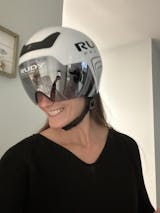How Running Sunglasses Help You Run Faster, Farther

Stop squinting! Facial tension leads to full-body tension — and slower running.
Like a pair of high-quality running shoes perfectly fitted to your feet, sunglasses for running should boost your running performance. It’s true. Sunglasses can help you reach your full potential as a runner. They do this by neutralizing the need to squint in bright sun and allowing you to keep your face muscles loose and relaxed. When your face is relaxed, your neck and shoulders stay supple, which helps you maintain a fluid arm swing. And a fluid upper body translates into an equally fluid leg stride. All this adds up to running faster with more economy and efficiency, which means you can run farther — and it all starts with a relaxed face.
Next time you’re out for a run on a sunny day, try this experiment: Run 30 minutes without sunglasses on and note your rate of perceived exertion. Then run again for 30 minutes with your sunglasses on and note your perceived exertion. Odds are that the run without glasses will feel slightly harder. That difference is likely because you were squinting the whole time.
But the best running sunglasses keep you relaxed in other ways than just reducing sun glare. They also shield your eyes from irritants such as dust, bugs, and debris, which makes them essential for trail running. Sunglasses with broad lenses block sideways glare from reaching your eyes, which can cause you to squint. And, of course, let’s not forget the ultimate benefit of quality sunglasses: blocking UV rays that can damage your eyes.
What Makes the Best Sunglasses for Running?
Fit
Running sunglasses should fit snugly yet comfortably through even the most intense training sessions and races. Lightweight frames and lenses provide this comfort, which is enhanced by adjustable nose pads and temple arms that let you dial in the perfect fit.
Lenses
Impact-resistant lenses offer obvious physical protection. Scratch-resistant lenses also ensure your field of vision stays clear. The shape of the lens matters, as well. Sunglasses that wrap around the face provide a wide field of vision along with optical clarity and protection from glare, wind, and grit. Rudy Project’s running-specific sunglasses, such as the Propulse, feature a deep lens to ensure the wearer can see the terrain ahead without dropping their head to look down.
Lens Color
Match your lens color to the terrain you run in. The right color will boost clarity and optical sharpness, further reducing your eyes’ need to work harder than they have to. Spend a lot of time in direct sun on open roads and trails? Consider darker colors like grey/black (neutral feel) or brown (for contrast). Trails and low light conditions? Red or orange hue. Go with a green or purple lens for grassy, forested, green terrain. If you run in variable conditions, you can go with a photochromic lens that quickly switches between dark or clear and back again depending on the intensity of UV rays and sunlight hitting the lens.
Frames
Frames play a critical role in fit, but they also impact vision. Rudy Project’s running-specific frames feature strategic vent holes that boost airflow into and around the sunglasses. This feature does double duty: It reduces the chances of your sunglasses fogging up from heat, and it also keeps your face cool by moving body heat off your face and out the top and sides of your eyes. To find the perfect fit for your style preference and performance needs, check out these frames on Rudy Project’s Propulse, Rydon, Astral, Kelion, and Spinshield Air running sunglasses.










